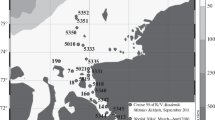Abstract
Since the mass development of halophilic bacteria in 1980 and the subsequent decline of the community in 1982, no new mass development of bacteria has occurred in the Dead Sea, and bacterial numbers have remained extremely low. The lake’s salinity, and more specifically the divalent cation concentration, have increased greatly during the last ten years. To quantitate the activity of the community of heterotrophic bacteria in the Dead Sea water column, rates of incorporation of amino acids, glycerol, and acetate were measured, both during the 1980–1981 bloom and in recent years. With the development of the bloom, rates of incorporation amino acids, glycerol and acetate increased. Concomitant with the decline in bacterial numbers, the incorporation rates of amino acids and acetate decreased at the end of 1980-beginning of 1981, while glycerol incorporation rates remained high for one more year. Measurements in 1989 and in 1991 showed very low but significant incorporation rates (three to four orders of magnitude lower than during the 1980–1981 bloom). By the use of specific inhibitors, it was shown that the remaining activity was due to halophilic archaeobacteria. The mechanism of the long-term survival of a small active bacterial community in the Dead Sea in the absence of primary producers and other obvious sources of organic carbon, and at divalent cation concentrations greatly exceeding those enabling growth, is still unknown.
Similar content being viewed by others
References
Anati, D.A., and Shasha, S., 1989a. Dead Sea surface-level changes.Israel Journal of Earth Sciences 38: 29–32.
Anati, D.A, and Shasha, S., 1989b. The stability of the Dead Sea stratification.Israel Journal of Earth Sciences 38: 33–35.
Anati, D.A, Stiller, M., Shasha, S., and Gat, J.R., 1987. Changes in the thermo-haline structure of the Dead Sea: 1979–1984.Earth and Planetary Science Letters 84: 109–121.
Beyth, M., 1980. Recent evolution and present stage of Dead Sea brines. In: A. Nissenbaum (Ed.)Hypersaline Brines and Evaporitic Environments. pp. 155–165. Elsevier, Amsterdam.
Fendrich, C., and Schink, B., 1988. Degradation of glucose, glycerol and acetate by aerobic bacteria in surface water of Great Salt Lake, Utah, USA.Systematic and Applied Microbiology 11: 94–96.
Kamekura, M., Oesterhelt, D., Wallace, R., Anderson, P., and Kushner, D.J., 1988. Lysis of halobacteria in Bacto-peptone by bile acids.Applied and Environmental Microbiology 54: 990–995.
Karl, D.M., 1986. Determination ofin situ microbial biomass, viability, metabolism, and growth. In: J.S. Poindexter and R. Leadbetter (Eds)Bacteria in Nature. Vol. 2. pp. 85–176. Plenum, New York.
Krumgalz, B.S., and Millero, F.J., 1982. Physico-chemical study of the Dead Sea waters. I. Activity coefficients of major ions in Dead Sea water.Marine Chemistry 11: 209–222.
Kushner, D.J., 1978. Life in high salt and solute concentrations: halophilic bacteria. In: D.J. Kushner (Ed)Microbial Life in Extreme Environments. pp. 317–368. Academic, New York..
LaRock, P.A., Lauer, R.D., Schwarz, J.R., Watanabe, K.K., and Wiesenburg, D.A., 1979. Microbial biomass and activity distribution in an anoxic, hypersaline basin.Applied and Environmental Microbiology 37: 466–470.
Mullakhanbhai, M.F., and Larsen, H., 1975.Halobacterium volcanii spec. nov., a Dead Sea halobacterium with a moderate salt requirement.Archives of Microbiology 104: 207–214.
Oren, A., 1983. Population dynamics of halobacteria in the Dead Sea water column.Limnology and Oceanography 28: 1094–1103.
Oren, A., 1985. The rise and decline of a bloom of halobacteria in the Dead Sea.Limnology and Oceanography 30: 911–915.
Oren, A., 1988. The microbial ecology of the Dead Sea. In: K.C. Marshall (Ed.)Advances in Microbial Ecology. Vol. 10. pp. 193–229. Plenum. New York.
Oren, A., 1989. Halobacteria in the Dead Sea in 1988–1989: novel approaches to the estimation of biomass and activity. In: E. Spanier, Y. Steinberger and M. Luria (Eds)Environmental Quality and Ecosystem Stability. Vol. IV-B. pp. 247–255.Israel Society for Ecology & Environmental Quality Sciences, Jerusalem.
Oren, A., 1990a. Estimation of the contribution of halobacteria to the bacterial biomass and activity in solar salterns by the use of bile salts.FEMS Microbiology Ecology 73: 41–48.
Oren, A., 1990b. The use of protein synthesis inhibitors in the estimation of the contribution of halophilic archaebacteria to bacterial activity in hypersaline environments.FEMS Microbiology Ecology 73: 187–192.
Oren, A., 1991. Estimation of the contribution of archaebacteria and eubacteria to the bacterial biomass and activity in hypersaline ecosystems: novel approaches. In: F. Rodriguez-Valera (Ed.)General and Applied Aspects of Halophilic Bacteria. pp. 25–31. Plenum, New York.
Oren, A., and Shilo, M., 1982. Population dynamics ofDunaliella parva in the Dead Sea.Limnology and Oceanography 27: 201–211.
Ward, D.M. and Brock, T.D., 1978. Hydrocarbon degradation in hypersaline environments.Applied and Environmental Microbiology 35: 353–359.
Wright, R.T., and Hobbie, J.E., 1965. The uptake of organic solutes in lake water.Limnology and Oceanography 10: 22–28.
Zehr, J.P., Harvey, R.W., Oremland, R.S., Cloern, Jr, J.E., George, L.H., and Lane, J.L., 1987. Big Soda Lake (Nevada). 1. Pelagic bacterial heterotrophy and biomass.Limnology and Oceanography 32: 781–793.




